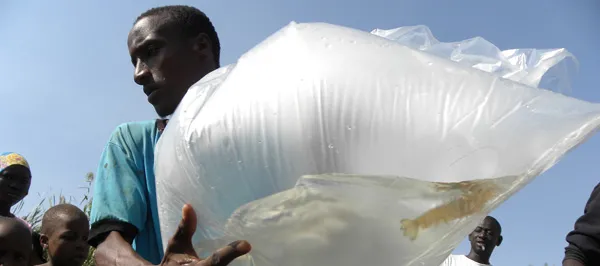
Photo by Susanne Sokolow: Workers preparing African river prawns to consume parasite-carrying aquatic snails in Senegal. The effort, led by Stanford researchers, is one of the projects funded by the Stanford Woods Institute for the Environment.
Stanford Report - June 20, 2013 - by Terry Nagel
More frequent bridge failures are one of the risks the public faces from a changing climate. Swiftly moving storm water can scour the dirt and rocks from around bridge piers, leading to collapse.
But policymakers soon may have help prioritizing which bridges to strengthen first, thanks to new research funding from the Stanford Woods Institute for the Environment.
A new project assessing the impact of climate change on bridge infrastructure is one of seven Environmental Venture Projects selected for funding this week by Stanford Woods, which advances interdisciplinary research aimed at finding practical solutions to major environmental and sustainability challenges.
The 2013 Environmental Venture Projects enable interdisciplinary research studies that propose practical solutions to major sustainability challenges.
Other projects include an "eDNA" breakthrough for measuring marine animal populations and a natural approach to controlling snails that carry a debilitating parasitic infection.
The seven innovative projects will receive grants totaling $1.25 million during the next two years. They were selected by an interdisciplinary faculty committee led by Stanford Woods Senior Fellows Jenna Davis and Jamie Jones.
Environmental Venture Projects (EVPs) are transformative and often high-risk projects that represent new collaborations among Stanford faculty who have not previously worked together. This year's awards include seven teams with 19 faculty members, nine of who are participating for the first time.
The Stanford Woods Institute has awarded more than $8.5 million in Environmental Venture Project grants to 56 research teams working in 24 countries since the annual program started in 2004. These projects have garnered more than $39 million in follow-on funding and have involved faculty from all of Stanford University's seven schools.
This year one of the projects, the eDNA marine animal population measurement tool, will be funded by The Seaver Institute, which provides seed money to creative individuals pursuing their passion with innovative projects that have the potential to catalyze change.
Previous Environmental Venture Projects have resulted in clean drinking water in Africa, biodegradable plastic from waste gas, protection for endangered species in California, biodegradable composite boards for construction, clean energy from wastewater, and low-cost mobile toilets in Haiti.
The 2013 Environmental Venture Projects are:
"Assessing Climate Change Impact on Transportation Infrastructure Vulnerability and Sustainability"
A team led by Sarah Billington (Civil and Environmental Engineering), with Noah Diffenbaugh (Environmental Earth System Science) and David Freyberg and Oliver Fringer (both Civil and Environmental Engineering), will study the impact of climate change on infrastructure vulnerability with a focus on scour, which is the primary cause of highway bridge failure in the United States. In order to better predict scour, researchers will link climate, river and sediment dynamics, and impacts for a wide range of bridges and configurations, allowing policymakers to make sound choices in prioritizing infrastructure renewal.
"Connecting Aboriginal Land Use Management Strategies, Mammal Extinction Rates and Shifts in Fire Regimes in a Changing Climate"
This team, led by Rebecca Bliege Bird (Anthropology), with team members Risa Wechsler (Physics), Douglas Bird (Anthropology) and Luis Fernandez (research associate), will help Australian environment conservation specialists understand how to promote species conservation while supporting the traditional livelihoods of Martu tribe members. The models developed for balancing biodiversity conservation with cultural sustainability will have broad applications throughout much of arid Australia.
"eDNA for Quantitative Macroorganism Marine Animal Monitoring of Ocean Waves"
Obtaining a census of marine life is important to understanding changes in marine ecosystems that result from stressors such as overfishing, ocean acidification, hypoxia, pollution and biological invasions. Traditional monitoring depends on individuals who count marine populations. It is invasive, expensive, time-consuming and error-prone. Principal investigator Alexandria Boehm (Civil and Environmental Engineering), joined by Larry Crowder (Biology, Hopkins Marine Station) and Ryan Kelly, Kevan Yamahara and Jesse Port (all with the Center for Ocean Solutions), plans to measure marine populations more efficiently by sequencing environmental DNA (eDNA) in water samples – that is, evaluating tissue cells and waste shed by marine life to measure the distribution, diversity and abundance of the organisms present.
"High Throughput Precision Measurement Tools for Insect-Parasite Ecology in Field Settings"
Insect-borne diseases are one of the largest causes of human death, yet we have no way of predicting and controlling outbreaks. This project, led by Manu Prakash (Bioengineering), with assistance from David Schneider (Microbiology and Immunology), proposes a device that will screen insect vectors in their natural habitat with minimal human intervention. It will use hydrogel-based low-cost microfluidic chips, baited with odorants, to capture single nanoliter volume droplets of saliva per insect bite from thousands of individual mosquitoes and test for both vector species and pathogens. It may lead to early warning systems for epidemics, monitoring of the evolution of insecticide resistance and a better understanding of how vector-borne diseases are transmitted.
"Lead Contaminated Topsoil and Food in Rural Bangladesh"
Human exposure to lead in the environment causes irreversible impairment of intellectual function. This project will evaluate the severity of lead poisoning in rural Bangladesh and identify the pathway of exposure to help develop focused prevention strategies. It will provide important evidence to support policy responses that reduce lead from the environment, not only in Bangladesh but also in other regions where lead contamination is a known risk to health and development. It will be led by Stephen Luby (Medicine), with Scott Fendorf (Environmental Earth System Science), Pascaline Dupas (Economics) and Rosamond Naylor (Environmental Earth System Science and director of the Program on Food Security and the Environment).
"New Solutions for Global Control of Parasitic Infections: The Case of Schistosomiasis"
Instead of treating a debilitating parasitic infection called schistosomiasis with drugs, this project aims to develop methodologies for controlling the snail populations that are the cause of the disease in developing countries. Principal investigator Michael Hsieh (Urology) and team members Giulio De Leo (Biology, Hopkins Marine Station) and Susanne Sokolow (postdoctoral scholar) will introduce river prawns, a native crustacean predator that consumes snails, as an environmentally safe and effective snail control option. This approach might offer a "triple win" solution by amplifying the positive effect of traditional drug treatment, possibly eradicating the disease from some areas, and offering a source of protein and marketable goods. The 20/20 Initiative Inc. is a partner in this project.
"Unraveling the Great Ammonium Debate in the San Francisco Bay-Delta Using a Novel Underway Analytical System"
One of the reasons for the dramatic decline of native fish species in the San Francisco Bay-Delta may be massive outputs of ammonium from regional wastewater treatment plants. There is a pressing need to understand the distribution of ammonium and its impact on phytoplankton, the organisms that form the base of the marine food chain. This project will link satellite remote sensing of phytoplankton with a real-time marine sampling system on a research vessel to determine how physical and chemical properties interact to control the fate and distribution of phytoplankton in the Bay-Delta. It will be led by Christopher Francis (Environmental Earth System Science) with team members Kevin Arrigo (Environmental Earth System Science) and Stephen Monismith (Civil and Environmental Engineering).




